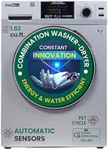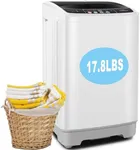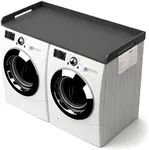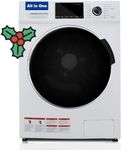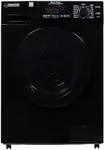Buying Guide for the Best All In One Washers And Dryers
Choosing an all-in-one washer and dryer can be a great solution for saving space and simplifying your laundry routine. These machines combine both washing and drying functions in a single unit, making them ideal for small apartments, condos, or homes with limited laundry space. When selecting the best all-in-one washer and dryer for your needs, it's important to consider several key specifications to ensure you get the right fit for your lifestyle and laundry habits.CapacityCapacity refers to the amount of laundry the machine can handle in one cycle, usually measured in cubic feet. This spec is important because it determines how much laundry you can wash and dry at once. Smaller capacities (around 2-3 cubic feet) are suitable for individuals or couples with light laundry needs, while larger capacities (4-5 cubic feet or more) are better for families or those who do larger loads. Consider your typical laundry load size and frequency to choose the right capacity for you.
Spin SpeedSpin speed, measured in revolutions per minute (RPM), indicates how fast the drum spins during the spin cycle. Higher spin speeds extract more water from clothes, reducing drying time. Spin speeds can range from 800 to 1600 RPM. For everyday laundry, a spin speed of around 1200 RPM is usually sufficient. If you frequently wash heavy items like towels or bedding, a higher spin speed can be beneficial. Choose a machine with a spin speed that matches your laundry needs to optimize drying efficiency.
Drying TechnologyAll-in-one washers and dryers use different drying technologies, such as vented, ventless (condenser), or heat pump. Vented models expel moisture outside, while ventless models condense moisture and collect it in a tank or drain it away. Heat pump models are more energy-efficient and gentle on clothes. Consider your installation options and energy efficiency preferences when choosing the drying technology. Ventless models are ideal for homes without external venting options, while heat pump models are great for energy-conscious users.
Wash and Dry CyclesThe variety and customization of wash and dry cycles can greatly impact the convenience and effectiveness of your laundry routine. Look for machines that offer a range of cycles, such as delicate, heavy-duty, quick wash, and steam options. Some models also have specialized cycles for specific fabrics or stain removal. Think about the types of clothes you wash most often and any specific laundry needs you have, such as allergy care or wrinkle reduction, to choose a machine with the right cycle options for you.
Energy EfficiencyEnergy efficiency is an important consideration for both environmental impact and utility costs. Look for machines with high energy efficiency ratings, such as those certified by ENERGY STAR. These models use less water and electricity, which can save you money in the long run. Consider your usage patterns and the potential savings on your utility bills when evaluating energy efficiency. An energy-efficient model is a good choice for frequent users or those looking to reduce their environmental footprint.
Noise LevelNoise level, measured in decibels (dB), indicates how loud the machine is during operation. This is particularly important if your laundry area is near living spaces or bedrooms. Quieter models typically operate at around 50-60 dB, while louder ones can exceed 70 dB. If noise is a concern, look for machines with noise reduction features or lower decibel ratings. Consider the placement of your washer and dryer and how much noise you can tolerate to choose a model that won't disrupt your household.
Size and InstallationThe physical dimensions of the all-in-one washer and dryer are crucial, especially if you have limited space. Measure the area where you plan to install the machine to ensure it will fit comfortably. Also, consider the type of installation required, such as electrical and water connections. Some models are designed for easy installation in tight spaces, while others may require more room for ventilation. Choose a size and installation type that matches your available space and setup capabilities.
